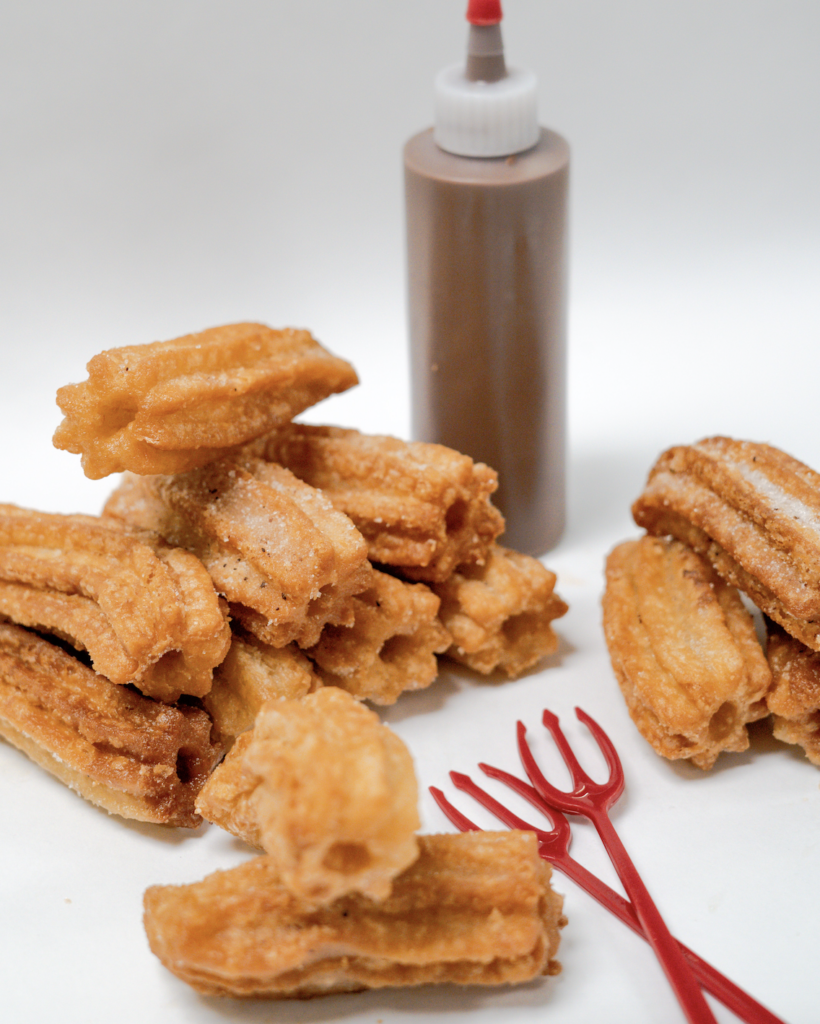A churro is a type of fried dough from Spanish and Portuguese cuisine, made with choux pastry dough piped into hot oil with a piping bag and large closed star tip or similar shape. They are also found in Latin American cuisine and in other areas that have received immigration from Spanish and Portuguese-speaking countries, especially in the Southwestern United States and France.
In Spain, churros can either be thin or long and thick, where they are known as porras in some regions. They are normally eaten for breakfast dipped in champurrado, hot chocolate,dulce de leche or café con leche.Cinnamon sugar is often sprinkled on top.
Another theory is that the churro was made by Spanish shepherds to substitute for fresh baked goods. Churro paste was easy to make and fry in an open fire in the mountains, where shepherds spend most of their time.
Preparation
According to food historian Michael Krondl, “today’s churro is not that different from a recipe for a flour and water fritter that you find in Apicius, a Roman cookbook dating from the 1st Century AD. And there are recipes from the Ancient Greeks but it’s probably even older than that. In the Mediterranean basin it’s basically been around forever”
Churros are fried until they become crunchy, and may be sprinkled with sugar. The surface of a churro is ridged due to having been piped from a churrera, a syringe-like tool with a star-shaped nozzle. Churros are generally prisms in shape, and may be straight, curled or spirally twisted.
Like pretzels, churros are sold by street vendors, who may fry them freshly on the street stand and sell them hot. In Spain and much of Latin America, churros are available in cafes for breakfast, although they may be eaten throughout the day as a snack. Specialized churrerías, in the form of a shop or a trailer, can be found during the holiday period. In addition, countries like Colombia, Peru, Spain, and Venezuela have churrerías throughout their streets. In Portugal, they are commonly eaten at carnivals, fairs and other celebrations, where they are made freshly at street stands.
The dough is a mixture of flour, water and salt. Some versions are made of potato dough. Depending on the recipe, it may not be vegan, they can contain butter, milk or eggs.
There are also two slightly different snacks in Portugal, called porra and fartura, which are filled with jelly instead of the doce de leite, traditional to Brazilian churros.The origin of churros is unclear. One theory suggests the concept was brought to Europe from China by the Portuguese.[4] The Portuguese sailed for the Orient and as they returned from Ming-dynasty China to Portugal, they brought along with them new culinary techniques, including altering dough for youtiao, also known as yóuzháguǐ in southern China which bears a resemblance to the churro. The new pastry was soon introduced to Spain, where it was modified to have the dough extruded through a star-shaped nozzle rather than pulled.

